Sunday 6th December 2020

I always know something serious is happening when a new initiative is upgraded from being described as “ground breaking” in the media release to “game changer” . Mind you, the much derided NHS Covid app was once so described, but that must be the exception to the rule. Go North East (GNE)’s ‘virtual launch’ of its Voltra branded electric buses last weekend looked very much to be living up to said mantle so I couldn’t resist a quick trip to the north east yesterday to check out the “game changing” fleet of new buses.

They’re the “first fully-electric bus fleet in the North East” and come capable of “all-day service with a single overnight charge”. Total cost comes in at £3.7 million for the nine buses and depot infrastructure at GNE’s Gateshead Riverside garage where charging equipment has been installed for an eventual fleet of 30 such buses. GNE has invested £2 million with the rest coming from the Government’s Ultra-Low Emission Bus Fund.
GNE is keen to say the buses are powered by clean sources of electricity such as solar, wind and hydro which is very clever to know that is the particular blend of “juice” coming out the nozzle when the Gateshead bus garage switch is turned on each night.

The usual razzmatazz bus launch was not appropriate for current Covid times so instead we were all invited to enjoy an 83 second video play out on social media featuring a symbolic large switch switched on; atmospheric light emitting electricity represented by graphics across the Tyne bridges; images of all the on-board gizmos; and best of all, hero of the show, GNE’s much loved (and rightly so) managing director, Martijn Gilbert, emerging as the dry ice cleared from a mood lighted line up of buses ready for action behind the arm-folded serious-looking ‘we mean business’ Voltra driver and maintenance team. It was a Chloe Leach production (from the Leach-O’connell Consultancy) at its best. Even Secretary of State, Grant Shapps, saw fit to give it a retweet last week.
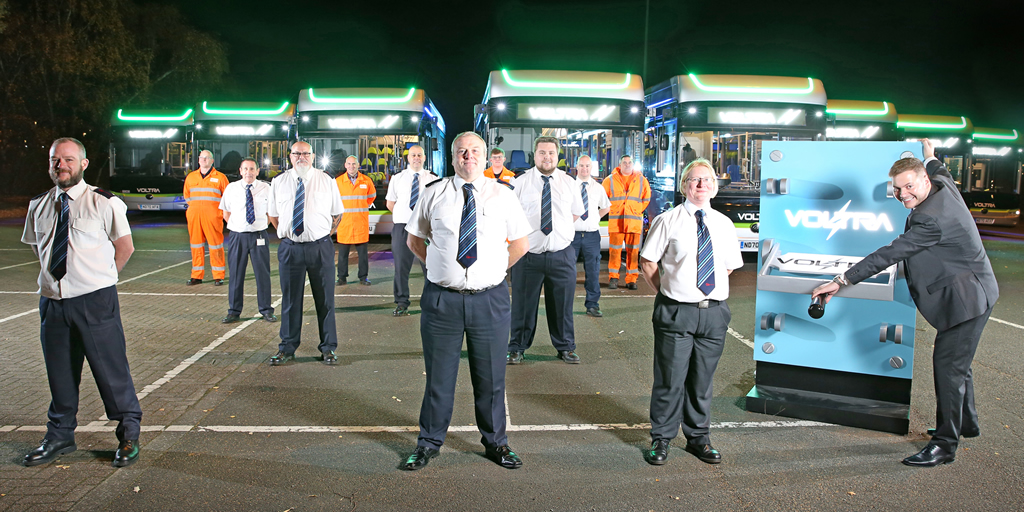
“We’ve flipped the switch. Now it’s your turn. Be the change. Voltra – zero emission electric buses for Gateshead and Newcastle” comes the suitably gravel sounding X-Factor style voice-over at the video’s end as the nine bus fleet head off into service in the darkness of an early dawn heralding in a new era of game changing bus travel – well, I think that’s what it was representing. It was a very good watch and, frankly, far better than any ceremonial dignitary ribbon cutting cup cake distributing boring speech giving real life launch any day. Take a look at it here.

The buses are the same Yutong E10 electric buses introduced by First Bus in Leeds which I reviewed a month ago; however that’s where the similarity ends. GNE have given these buses an eye catching (Best Impressions devised) “futuristic” silvery grey based livery with smart graphics which makes the best of the brick like bus shape as well as a well thought out interior creating a “bus of the future experience”.
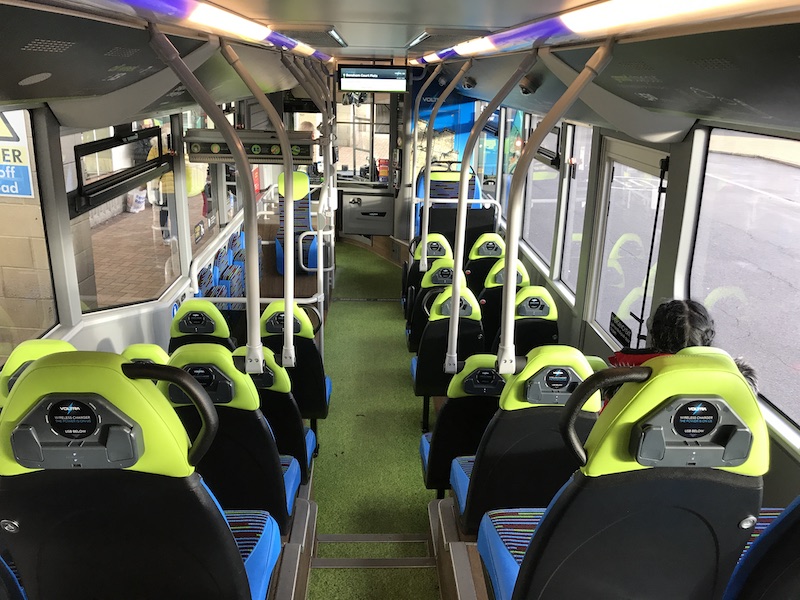
Alongside the usual next stop display and audio, wifi and at seat usb and wireless charging point, personal bell push, mobile phone holder and coat hook, the buses also feature tap-on, tap-off (a first for GNE – with a £3 a day, £13 a week cap) and air conditioning.
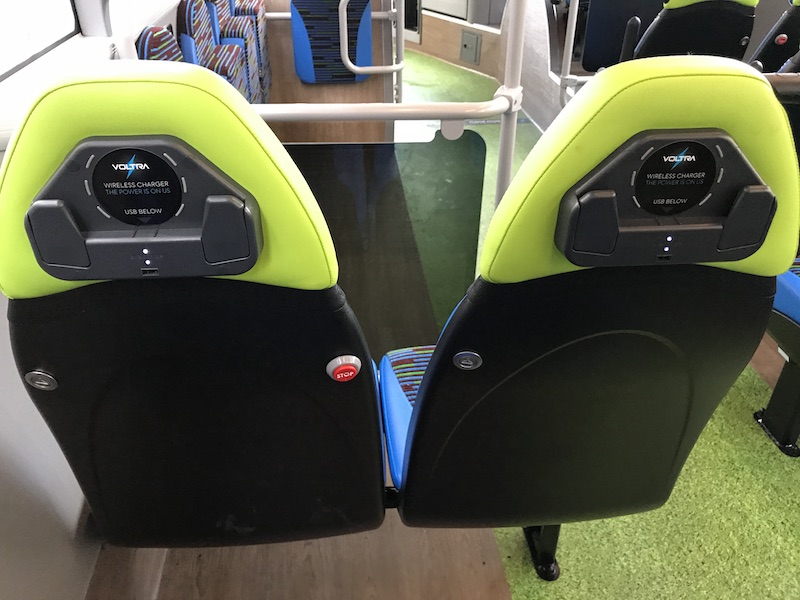
Like the Leeds buses there are 17 seats in the raised rear portion including some very high steps up to the rearmost 13…
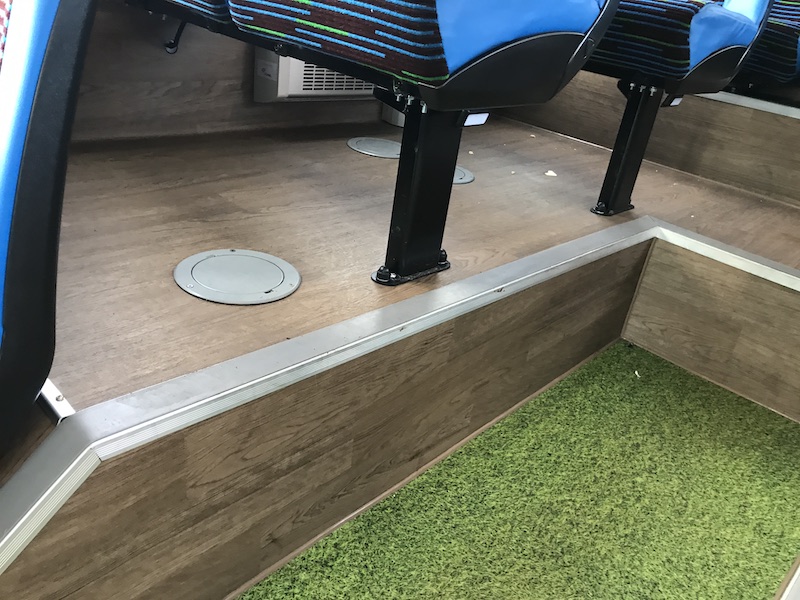
…. with 12 easy access seats in the front low floor section together with four tip up seats and a back to back arrangement over the offside front wheel arch making for 35 in all.

The seats themselves are described by GNE as “comfy and plush trimmed with stylish British moquette paired with environmentally friendly vinyl fabrics”.

They’re right. I found the seats very comfy and they certainly look plush and smart.

Voltra buses are being used on GNE’s circular route 53/54 which link Saltwell Park with Gateshead and Newcastle. As you’d expect there’s a very attractive leaflet to a style that matches the branding on the buses.


It contains a timetable, map and other helpful information.

As you can see, route 53/54 is an intensive and busy ten minute frequency round trip of just over half an hour service. Four buses are needed to run the clockwise (53) and anti-clockwise (54) circuits with stand time taken in central Newcastle.
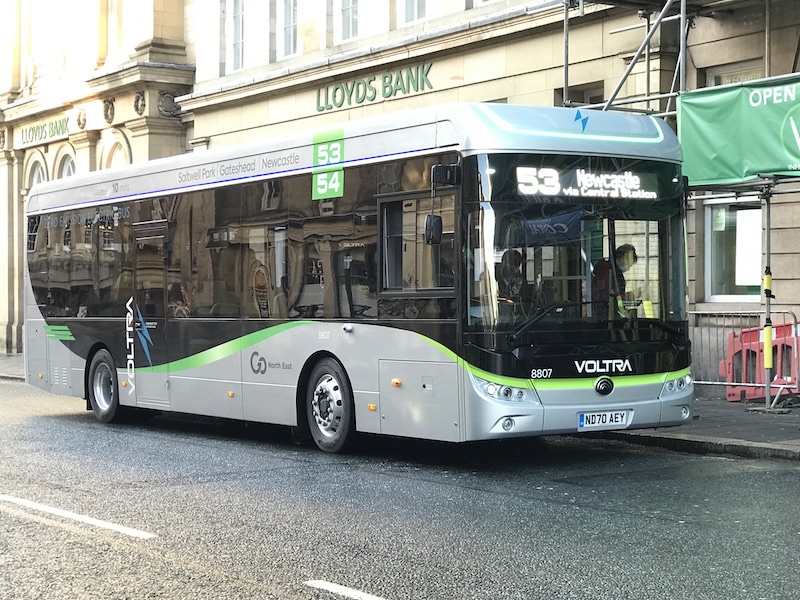
I took a couple of hop-on and hop-off rides both ways around the circuit yesterday morning and passenger numbers were fair bearing in mind the current tier 3 travel guidance in the north east. The busiest bus on route 54 coming into Gateshead Interchange had 18 adults and two children on board but many were couples or families able to sit together so there were no issues with social distancing. Mask wearing was noticeably good.
Inside the buses it was also noticeable the absence of full-on notices about Covid and all the associated stuff. Indeed the only reference to any restrictions/procedures was a subtle roping off of the back to back seats behind the driver and some small size symbols and messages on the rear of the wheelchair space facing next stop display, which were hard to read as they were so small.
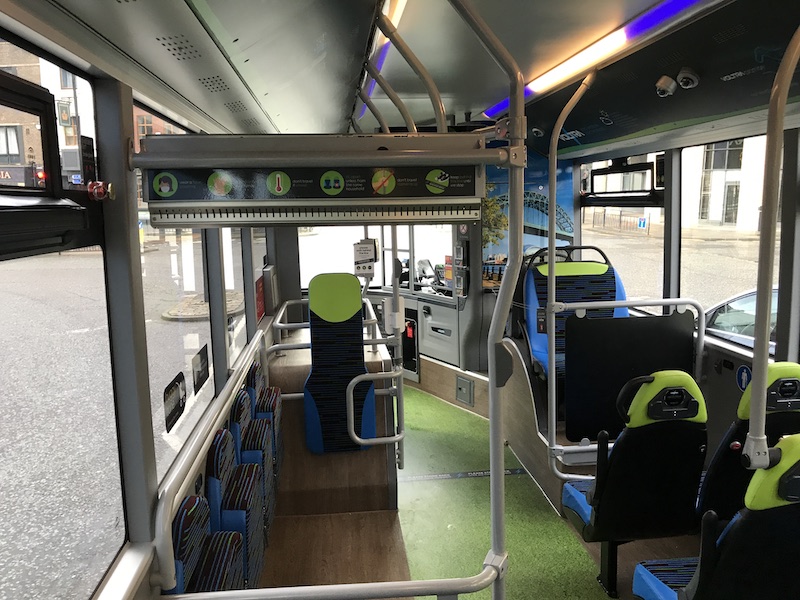
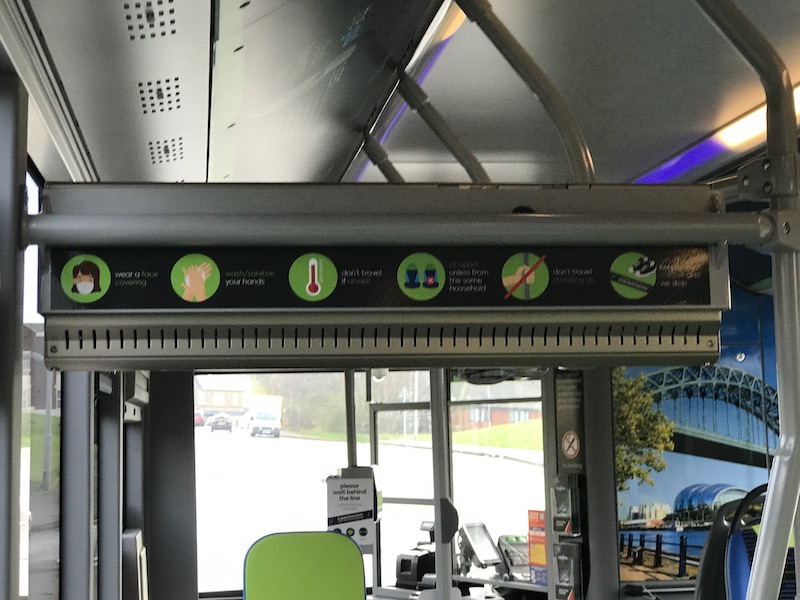
The roped off seats are the odd size ones over the front offside wheel where you’re not sure whether they’re meant for one or two people.
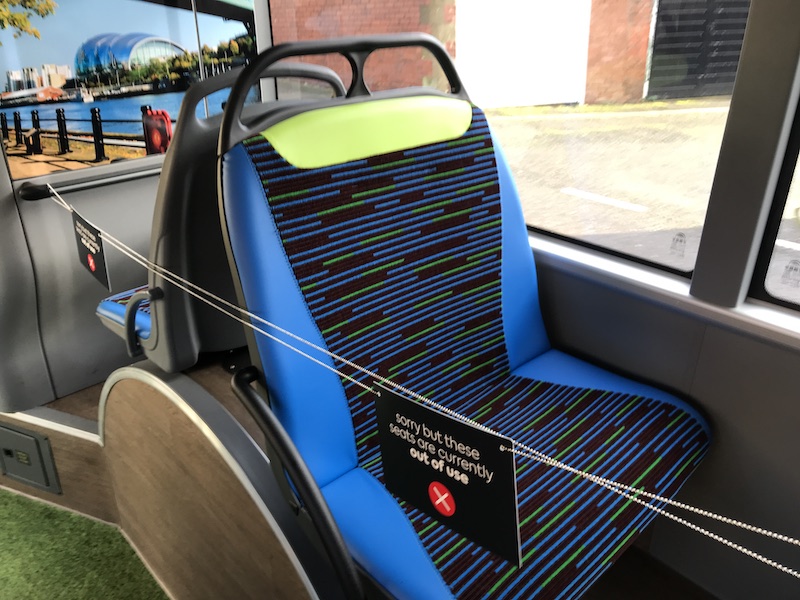
GNE have included a magazine style rack alongside the forward facing seat which makes it obvious it’s a single seat ….
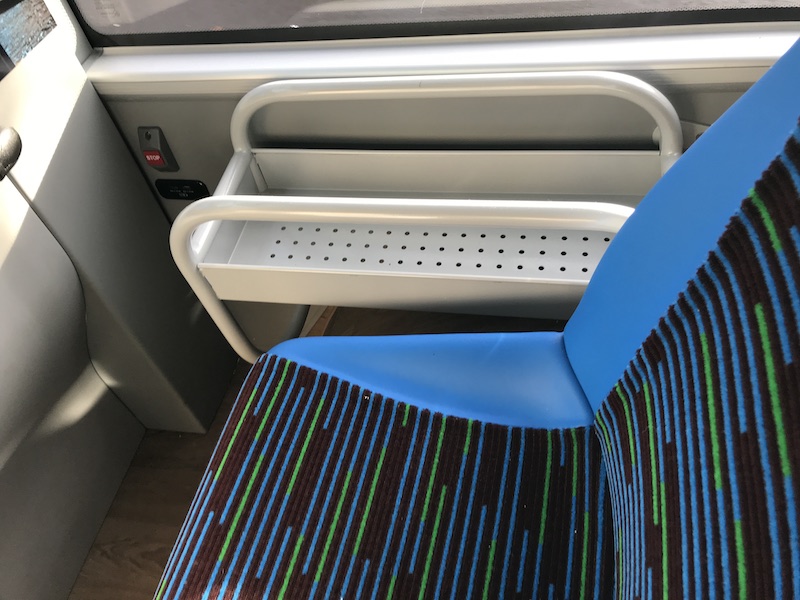
…. and the moquette design makes the wider rear facing seat also look like it’s for just one person. In any event they’re both currently out of use.
I was also struck by the absence of lots of shouty notices inside telling me how much carbon I’m saving by making a journey on an electric bus or similar exhortations, the main reference I spotted was as you board by the driver’s cab door and some subtle information on the well designed cove panels.
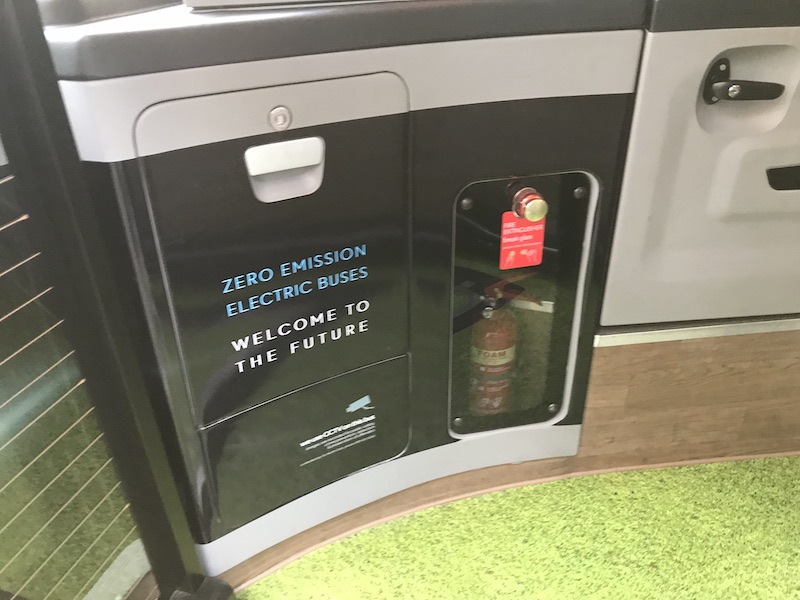
I applaud this approach as I’m more interested in helpful practical information nicely presented like a route map and ticket prices etc and these are tastefully included in these buses.
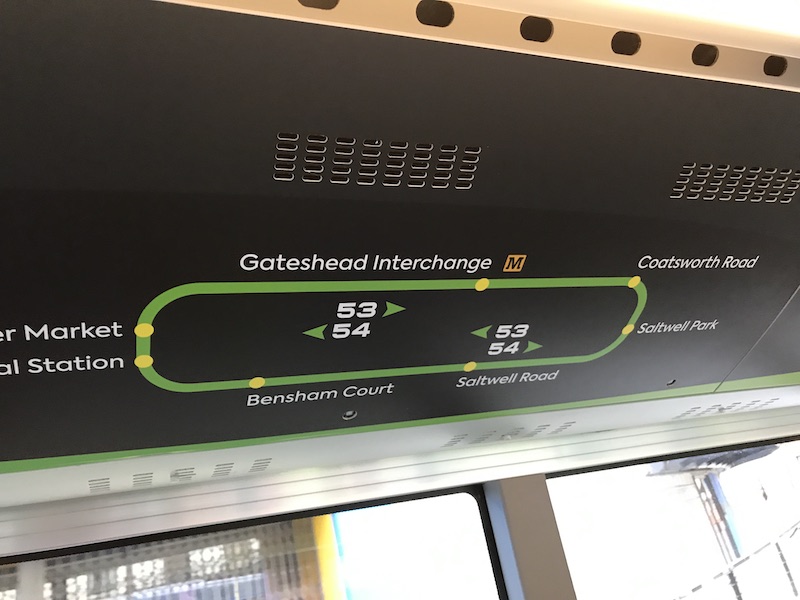

The Voltra brand name does feature inside the buses and this has connotations of electricity – voltage – and there are rightly references on the outside of the bus telling the wider community of its emission free status.
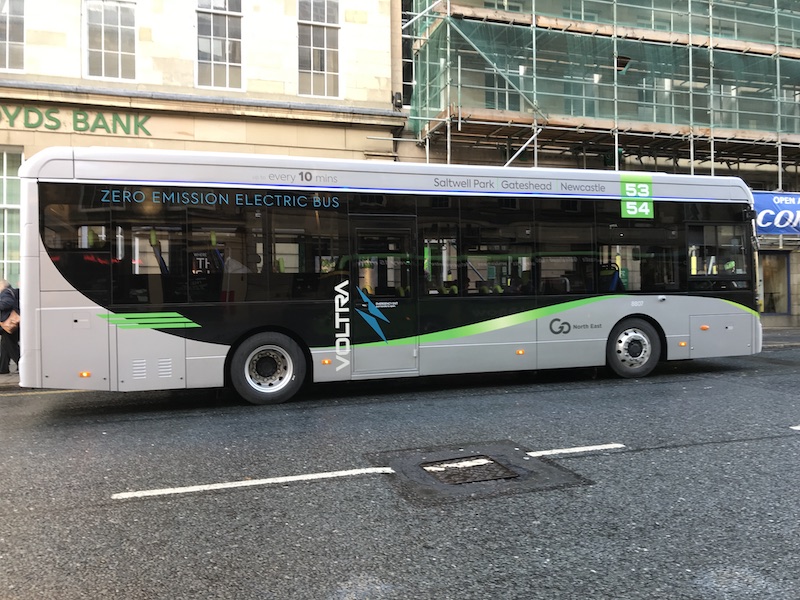
The interior ambiance created by the clever use of colour and lighting along with the smart moquette and novel ‘grass looking’ floor covering really does make for a very attractive look.
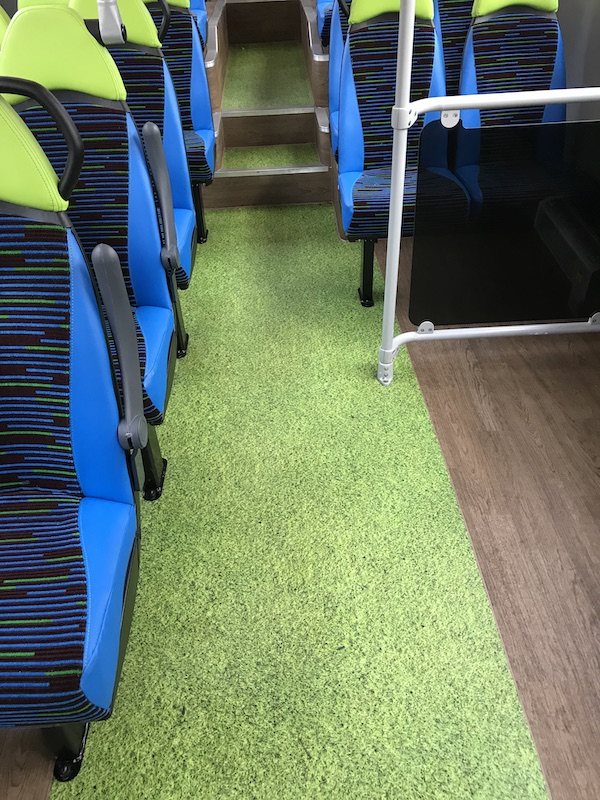
Although I noticed the rear “grass” was already looking a little dirty, but that may be to give a winter time ‘muddy’ effect, and if not, hopefully it will be nothing a good mop over won’t remove.

Another nice feature is the depiction in the panel behind the driver of a local iconic building or landmark.

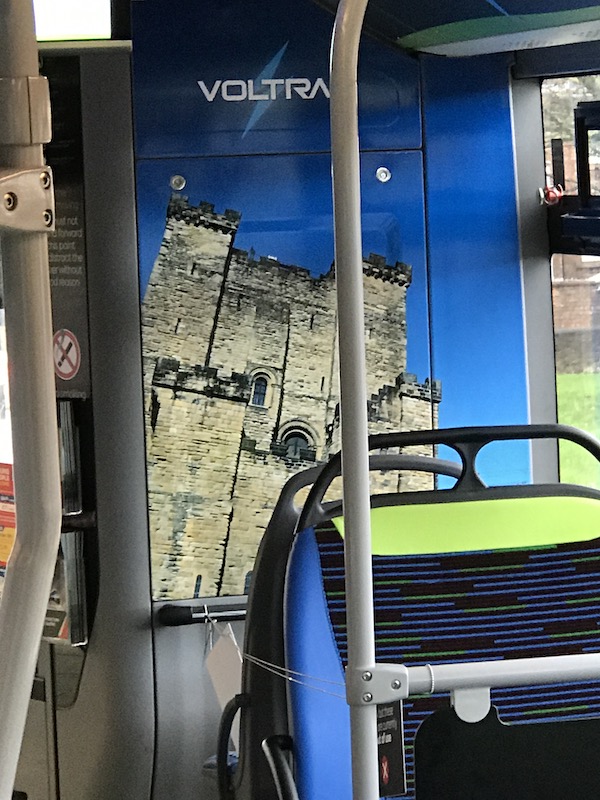
I didn’t have time to spot all nine, assuming each bus has a unique picture and I always think these additions are a great idea to make buses part of the local community. What about naming each bus with the building/landmark featured for even more effect?
It’s great to see GNE leading the way with innovation of this kind but it’s also essential to ensure “game changer” buses don’t get held up in traffic and become unreliable. Gateshead and Newcastle have a reputation for congestion and sure enough by lunch time yesterday there were delays and queues at the region’s hot spots.
Despite heroic attempts by GNE drivers there was inevitable minor bus bunching on an intensive service like the 53/54 which doesn’t venture far from crowded city centres and the inevitable impact on timekeeping. Some judicious bus priority wouldn’t go amiss – how about it Nexus?
All credit to GNE that the location of every bus is available on the company’s website and app so passengers can make informed choices of which bus to catch from any bus stop on the circuit, although it’s a shame the 53 and 54 are shown separately as it might be helpful for them to be combined on one map when waiting in the Saltwell Park area.
It was good to see all the buses I travelled on had full racks displaying the attractive timetable leaflet for passengers to pick up for those who prefer printed information (eg me)
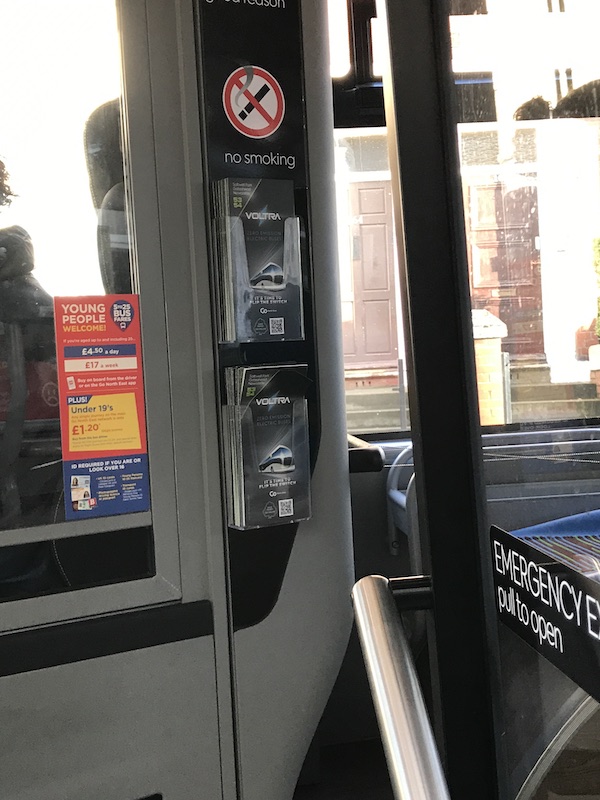
Despite enjoying concessionary travel by dint of age and complimentary travel by dint of a Go-Ahead career I thought I’d try out the new tap on and tap off facility and see if the £3 daily cap worked.

And I managed to remember to tap off each time, although on one bus the reader wasn’t working but the driver said I could use the one on the cab door instead. After my trips my credit card balance was showing the usual ‘holding’ deduction of 1p (twice, for some odd reason) on checking yesterday afternoon but checking this morning, both entries have disappeared and so far the expected £3 charge hasn’t been listed. Based on my try out with Brighton & Hove and Metrobus a year ago it’ll probably turn up some time tomorrow once the “back office” has done its bit.
The next stop displays weren’t working on the buses I travelled on yesterday and instead a smart Voltra brand name was displayed …
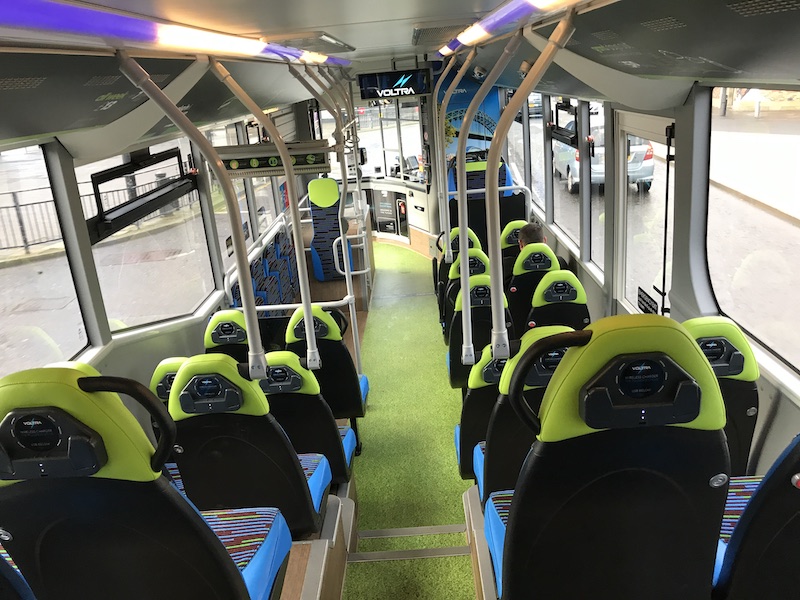
…. while on another bus the display had frozen at a stop in Bensham.

I understand there have been some initial teething problems with a fault developing on Friday but I’m sure it’ll soon be fixed
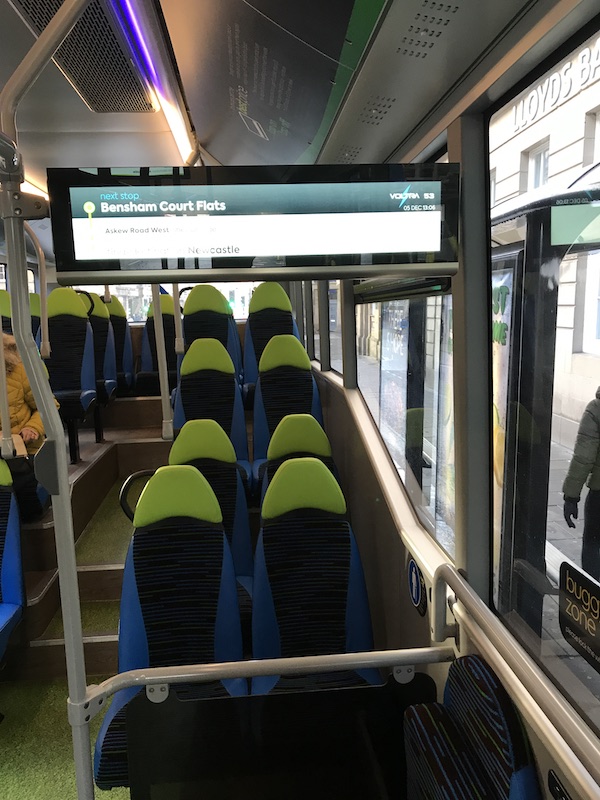
And it’s commendable a display is available facing the wheelchair bay (as shown above).
Voltra is a world away from the utilitarian look of the same buses in Leeds and shows what can be achieved with professional design input. Sure it costs more, but if we are to have any hope of getting motorists to “switch” on board, a professional approach to bus design and presentation is essential.
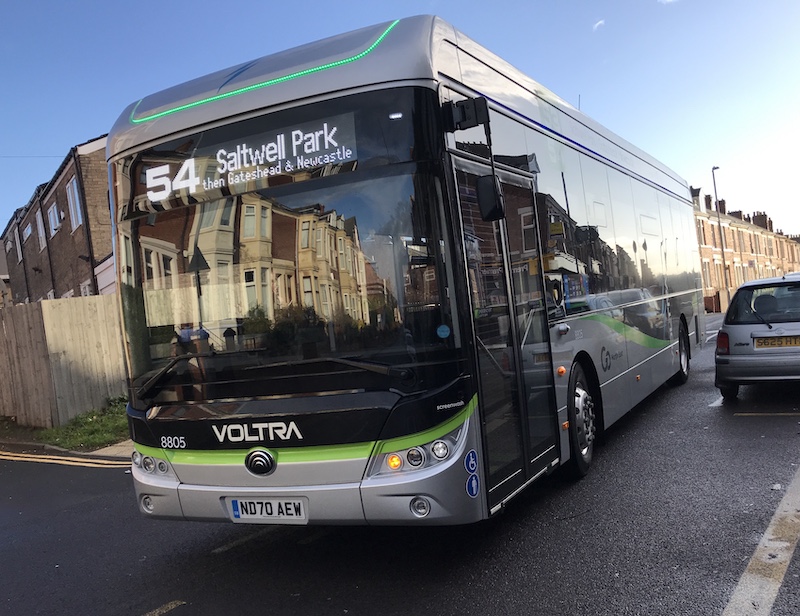
Much very careful thought has obviously gone into making these buses attractive and desirable. You can tell there’s been significant attention to points of detail that all add up to make a true “game changer”. It’s a worthy moniker.
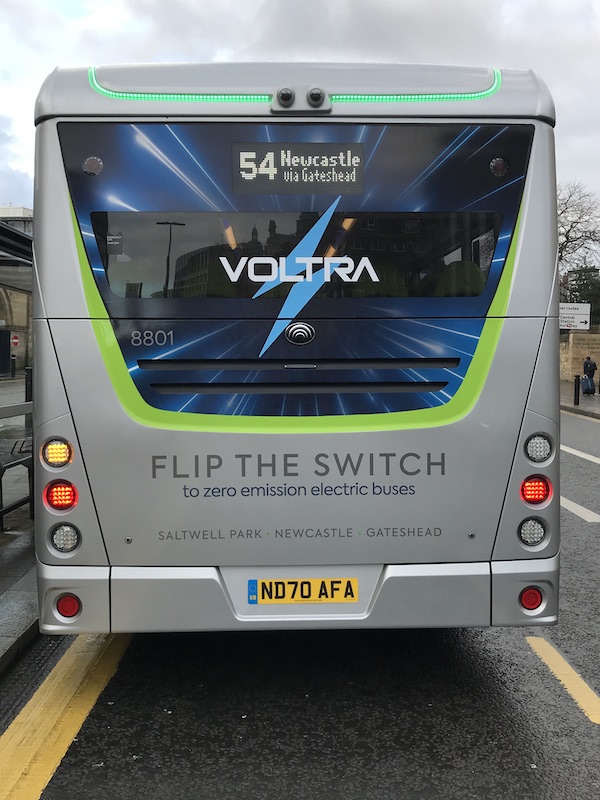
Well done to everyone involved.
Roger French


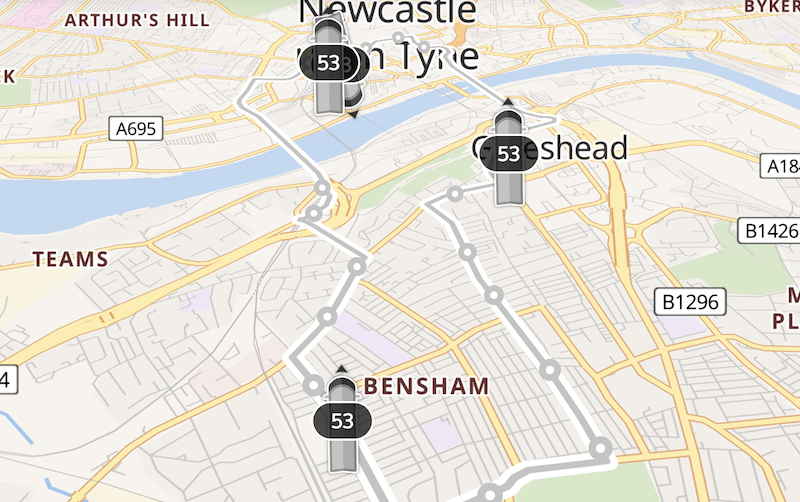
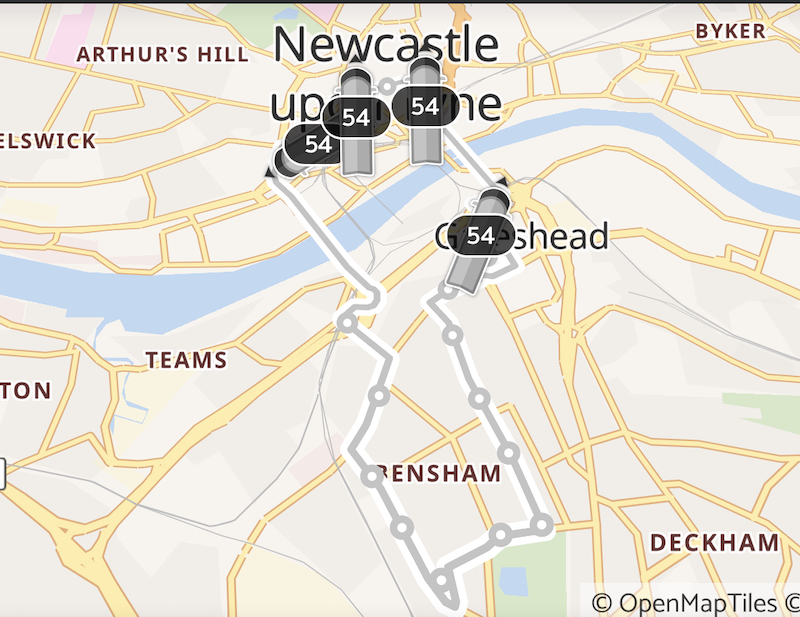
Completely baffled as to why there is no mention whatsoever of the extra comfort provided to passengers (and driver, FTM) by the lack of a diesel engine constantly chuntering away – no noise, no vibration.
You also seem to be overdoing the scepticism/sarcasm about how electric buses really will be a ‘game changer’ – why?! They *really* are! As are EVs in general… or do you scoff about those, too?
What difference does being held up in traffic make? It’s not got an engine so the only energy it uses when stuck in traffic is from heating and cooling – and I dearly hope these both utilise heat pump technology to make at least the heating side ~3 times more efficient than using purely resistive heaters. If not, whoever did the spec for the buses should be sacked.
Interestingly, https://pelicanyutong.co.uk/buses/e10-electric-bus/ shows it as having a 260 litre fuel tank… not sure what’s that’s all about (I have told them).
LikeLiked by 1 person
Clearly, the difference being held up in traffic makes is that it delays the bus, impacting on passengers and all round makes using buses less attractive to use!
LikeLike
Sadly I have to disagree about the livery. It looks like a breeze block with a typical Best Impression swoosh!
The interior is very nice though. Maybe the next operator with these buses will take the First Leeds example for the exterior and the GNE example for the interior.
LikeLike
In response to Martin W, I too feel it is quite ok to be sceptical about electric vehicles…. the power used to charge them has to generated someHOW and someWHERE… just because it’s not done on the vehicle itself does not make it instantly 100% environmentally friendly!!
Over 50% of our power still comes from burning coal and gas etc, and for some of the rest burning biomass still gives off CO2, even if the figures can be fudged to make out that’s ok because it took some in when it was growing.
Many companies are struggling to get the electricity suppliers to provide charging points which are man enough for a few “token” electric vehicles, so how on earth is the grid going to cope with the charging needs of over 25m vehicles that will require charging for long periods of the day or night in the future?
Regardless of how efficient and effective future batteries become, the charge to keep replenishing them still has to be brought to where it’s needed, and on a grid that can cope with everyone else wanting more too…
LikeLike
Hi Mackay,
I’m not sure Roger really intended to come across as unenthusiastic about EVs rather than all the hoop-la surrounding the launch of this particular example of them. But if you think EVs are not going to take over from ICEVs – almost entirely – and within the next 10-20 years then I’m afraid you are going to be disappointed. Yours may be just a personally held opinion or you may think everyone else agrees with you – I don’t know (surely you haven’t been living in a cave for the last 10 years and are aware, just for one example that HMG are planning to ban the sale of ICEVs within *9 years*?!), but be under no illusions; it is happening and will continue to do so at an ever-increasing and now completely unstoppable pace.
In the case of busses there are already ~400 fully electric ones operating nationally in the UK with that number again already on order (transportenvironment.org/press/new-electric-bus-orders-will-nearly-double-numbers-zero-emission-models-uk’s-roads). The UK currently has around 30k busses in total.
To cover the points you raised to exemplify your particular EV-scepticism:
1/ Where is the energy to charge EVs (unless you really mean ‘power’?) going to come from? You may be unaware that in the last ~15 years UK electricity demand has fallen by fully 16%. If all cars on UK roads became electric the extra electricity needed to charge them would increase total generation by ‘only’ 10%. You can work this out for yourself by multiplying the number of cars we have by their average annual mileage and then dividing that by 4 (a typical EV does roughly 4 miles to each kWh – unit – of electricity). Then compare that figure with the UK’s current annual electricity generation. If you add *all other road-based transport* that figure goes up by another 5%.
You may also be unaware that in 2018, *56%* of electricity generated or imported into the UK was lost due to conversion and transmission losses. So, if we can come up with a way of eliminating the need to ship electricity up and down the country we could be in a position of being able to hugely reduce electricity generation and have all our transport be electric *and* have a large surplus.
Question is, how do we do that? The answer is actually as simple as it is do-able. The government must mandate that all new buildings have the capability to generate the majority of their own power needs (mostly by using PV – photovoltaics or solar panels if you will but don’t confuse them with hot water ones) *BUT* (and this is the key to making it work) they must also have sufficient batter storage installed to cope with the load-shifting required to avoid straining the grid – both when the PV is generating and the energy not being used (ie during the day) to when it is mostly used (in a domestic context, this is during the evening). HMG must also reverse its trend of late and *encourage* the uptake of this type of technology on existing premises. Thus the bulk of energy generated is used locally and no need to ship it hundreds of miles incurring all that waste.
Yes (obviously) the sun does not always shine and we will have to have a generation and distribution grid system that can cope with that but even in 2018 (I don’t have more recent figures) nearly half of the UK’s total electricity generated came from renewables. There is about 70 square km of south-facing *industrial* roof-space in the UK. That alone would be easily enough to supply all the UK’s electrical energy needs (were it all covered in PV) and that doesn’t include homes – assuming there was adequate storage to cope.
Of course this does not deal with the question of *heat* – ~2/3 of overall energy used in the UK goes toward space and water heating and so we will have to get very clever very quickly to tackle this issue with renewables, too. But it is by no means impossible. Improving the thermal performance of buildings is key but so too is adopting much more efficient means of heating, predominantly using heat-pump technology. These make using electricity 2-4 times more efficient than just using traditional resistive heating devices. At the moment the tech is still relatively expensive to install but the prices (like that of EVs, batteries and PV) have fallen dramatically in the last 2 decades and will continue to do so to the pint where they will be at least as cheap as gas/oil systems if not cheaper. They will also be much cheaper to run – just like EVs – and have zero emissions thereby hugely improving our local urban environments and reducing the huge cost – finical and human – of emissions-induced respiratory diseases.
None of this is rocket science – it just needs a bit of vision, a lot of education and a desire to change things for the better… oh.. and some money!
2/ Biomass is a complete farce. Most wood pellets are imported to the UK from the US. Complete insanity. Making ‘green gas’ (methane) using bio-digesters is another matter and they will probably have a useful place in the future especially if the UK’s agricultural sector continues to play a significant role in the UKs GDP (though that looks increasing unlikely, post Brexit).
3/ I don’t understand your point about the problems with large-scale EV charging. You may be unaware that there is a roll-out of (car!) EV charging facilities going on with individual charge-points having up to 350kW capability. Again, none of this is technically challenging – it just needs the money and thought to be spent on it rather than building yet more fossil-fuel-based facilities.
Essay concludes…
LikeLiked by 1 person
What’s the need for the blazing light pollution on the bus roof? reminds me of the modern electric trains with a search light on the roof pointing at a pantograph nobody’s looking at and all this junk ending up into the night sky flushing out the views of the stars.i wonder if the concept of on/off switches have bypassed these people?
LikeLike
Interesting post as ever on a laudable initiative.
A few comments. It would be the highway authority (City Council)that would have to introduce bus priority measures, not Nexus.
The safety margin on the national grid is rather low at the moment, due to decommissioning old power plants while not delivering new capacity.
As MW states, the transmission of power is not 100% efficient, so more local generation and storage would help. Generating lots of PV energy whilst buses are on the road requires storage somewhere.
Finally, is this not something that was tried nearly 40 years ago with Chloride batteries?
LikeLike
In re lights shining on pantographs on train roofs . . . there are complex monitoring systems looking at pantographs to try to identify defects before the knitting comes down; and also to look at ways of improving maintenance. I believe that the light has to remain on all the time so that clearances under tunnels and bridges can be continually monitored, as darkness would interfere with such!!
In re electric buses . . . the decision to move towards full electric buses is a political decision, certainly in London . . . and we all know that London is a shining example of innovation, after all!! Remember that the DfT is based in London, and north of Watford “there be dragons”.
If the politicians are determined to have more pure-electric buses, and more to the point are prepared to contribute financially in substantial amounts, then it is no matter to bus companies where the actual power comes from.
LikeLike
When I rode these on day one of service I was impressed by the layout and how it’s so smooth the ride going from Gateshead to Newcastle in the past the vehicles on Voltra have previously been more diesel vehicles like Dennis Darts all are now no lo no we in the fleet the Optare Versas replaced them were once a joy to ride but these are still in the fleet with most taking a back seat role now then the last vehicle Wright Streetlites these are only young and the second oldest in the fleet in terms of Streetlite only becoming behind to Deptford Drifter lot
LikeLike
I do think the livery is a bit dull compared to the refreshing interior.
LikeLike
Great initiative but the interior colours? ‘’Blue and green should never be seen ‘’
LikeLike
If it’s ever decided to renationalise the buses, I hope Martijn Gilbert is put in charge.
LikeLike